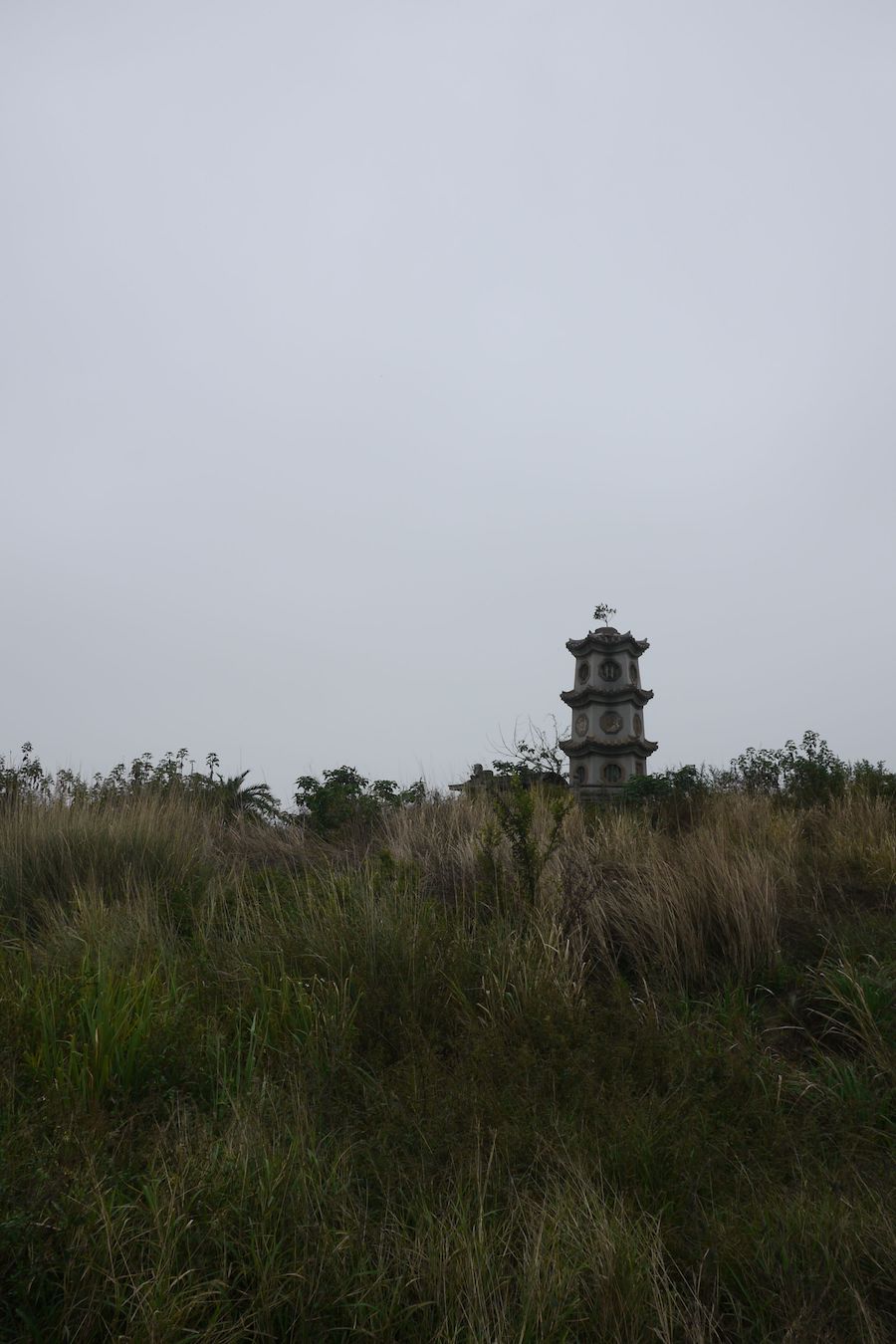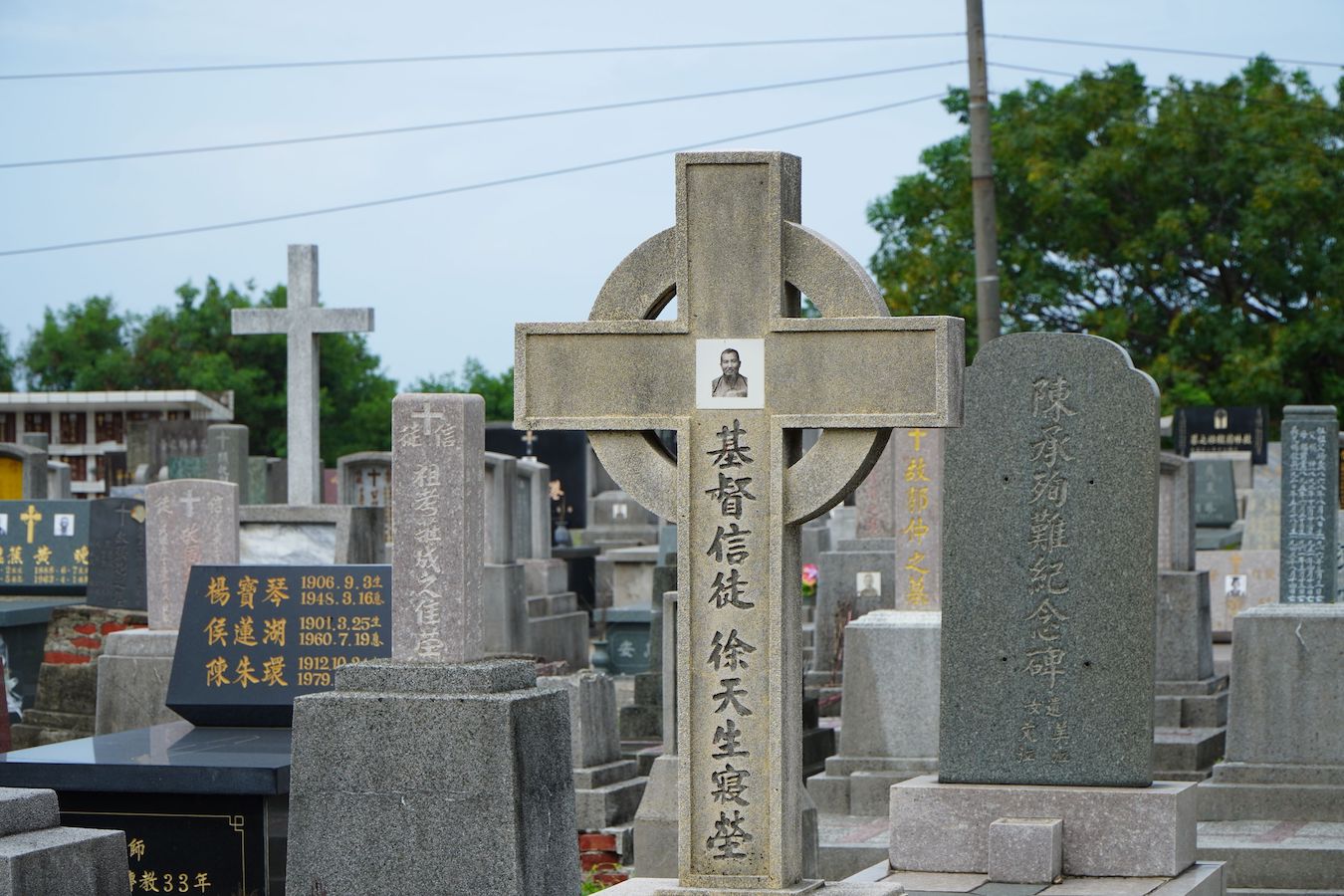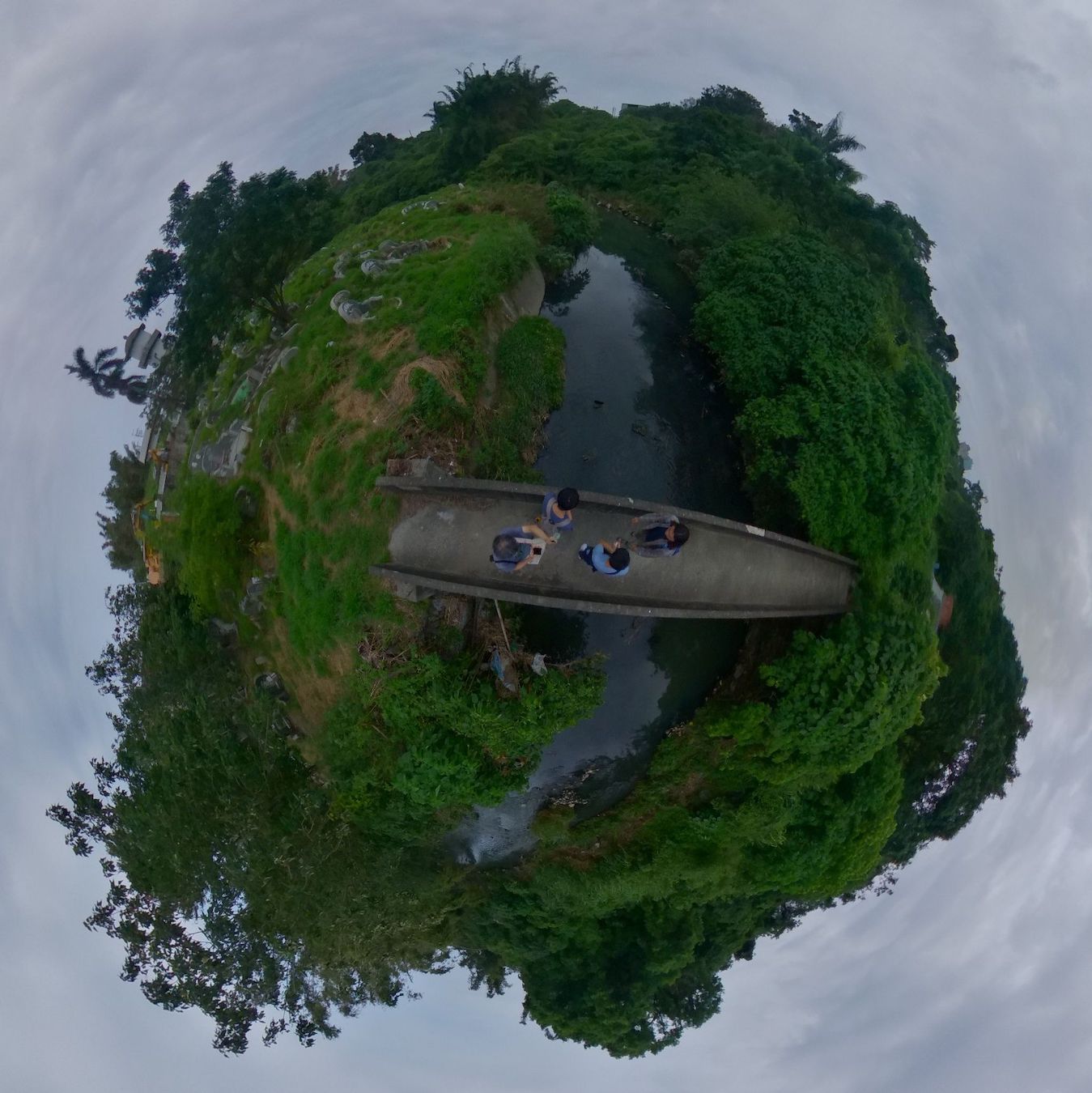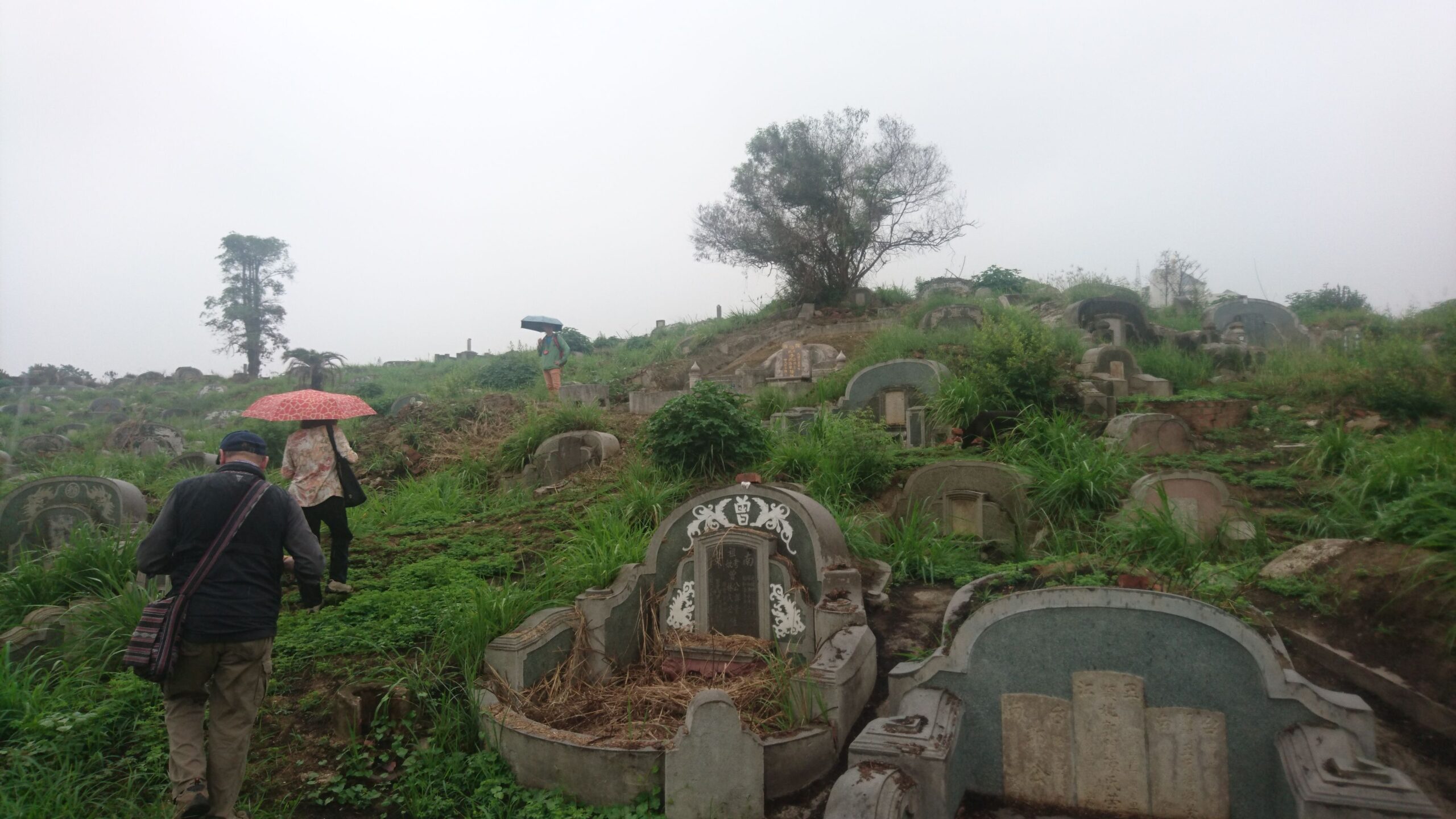by Tyng-Ruey Chuang
語言:
English
Photo Credit: Tyng-Ruey Chuang
THE NANSHAN GRAVESITE at the southern outskirt of the Tainan city central is a historical site of land burials that had been in use for hundreds of years until 2008 when it was forbidden for any further interment. The “no interment” rule follows an earlier order in 1991 by the Tainan City government to restrict new interments on the site. The “no interment” regulation is aligned with the general trend in Taiwan where the use of cremation has been much preferred over land burial in funeral practices. The Ministry of Interior of the Taiwan Government, for many years now, has been persistent in encouraging its people to use cremation to bid final farewell to the recently deceased. By one count, in 2017 there were only 38 land burials in Taipei City, the capital of Taiwan of about 2 million residents.

Part of the Nanshan Gravesite landscape. Photo credit: Tyng-Ruey Chuang
Cemeteries in Taiwan continue to function as sites of remembering but their roles have changed in the past decades. During the tomb-sweeping festival (清明節), on the 15th day after the March equinox every year, many Taiwanese families still hold traditional reunions at gravesites. They visit the tombs of their common ancestors, and pay their respect to the ancestors through rituals of food offering and incense burning. Nowadays however people more often meet at columbaria than gather at gravesites to remember the dead. The bodies of the ancestors would have been re-interred years ago where, by following the “bone-collecting” (撿骨) consuetude in Taiwan, but their remains were exhumed and the bones collected, cleansed, eventually burned, arranged in urns, and afterward stored at columbaria. In modern days, the newly departed loved ones, friends, and colleagues, are almost all cremated. Their urns rest at some columbaria.
Along with this general shift in burial practices, old gravesites in Taiwan are stripped out of their places as the sites for forging memories about the newly dead, as land burials are rarely being held. Furthermore, old tombs are left in destruction after re-interments. The vacated tomb plots on old gravesites are not reused because of the “no interment” regulation. Consequentially many public cemeteries in Taiwan are left in a sorrowful state of gradual decay as they cannot be renewed via new land burials.
The Nanshan Gravesite is a public cemetery. The historical significance of the site, and the extraordinary scale of its size and complexity, do not by itself warrant a future trajectory different from the fates of other public cemeteries in Taiwan. By some logic of land economics, local governments have development plans for old gravesites in Taiwan, especially for those that are near residential areas. The authorities seek ways to have tombs removed, whether voluntarily or not, from land plots planned for new development. The tomb-removal policies, and the systematic processes hence being implemented, have been seen over the entire island.

Part of the Christian Cemetery in the Nanshan Gravesite. Photo credit: Tyng-Ruey Chuang
The Nanshan Gravesite can be thought of as a field of memory about the many people who had traveled to and settled on the island over the years. The site is an embodiment of the traces and heritages of the human paths that all ended in Tainan. Diverse in their forms and styles, the tombs at Nanshan are visual markers of human stories. The inscriptions on the tombstones, as well as the materials used for the tombstones, hints at human lineage and movement. Folklore stories and religious beliefs are depicted by the rich artifacts embedded with the tomb structures. The uneven distribution and composition of the tombs at the site, with the heterogeneity in tomb type, size, year, and other aspects, seemingly mirrors a layered and complicated history of human settlement in the greater area of Tainan.
Because of the longevity and size of the burial site, along with the complexity and density of the tombs implanted, stacked, and layered over the area, the Nanshan Gravesite in recent years has become a focal point of contest about cultural heritage and landscape preservation. More and more people are aware of the uniqueness of the gravesite. But the clock is also ticking in the government’s planning to remove tombs from the area for land development.
Grassroots groups have sprung up to argue for the cultural and historical significance of the site, and to seek ways to preserve the site. As such, the usual assessment process for cultural heritage preservation has been activated, by the Tainan City government nevertheless, so as to conform with the Cultural Heritage Preservation Act of Taiwan. Sadly, the assessment process focuses only on the artifact level. It aims to identify tombs, and only tombs, to be preserved for their cultural and historical importance.
The preservation of individual tombs, no matter how significant they are, in our view is an awkward way in addressing old gravesites as cultural heritage sites. Nanshan Gravesite is more than the sum of all the tombs layered over the land area. It is the complexity of the whole that shall be conserved. Keeping some tombs but removing all others is to deprive the meaning of the site and the surviving tombs, as styles, inscriptions, and locations of tombs can only be understood in relation to the context given by the entirety of tombs.
We view the Nanshan Gravesite as a holistic cultural and natural landscape embedded with tombs of diverse origins and threaded with a multiplicity of heritage. This multiplicity of heritage consists of intangible cultural practices, such as tomb-construction, tomb-adornation, stone-carving, bone-collecting, and tomb-sweeping, but also of tomb materials and structures, human lineages, migration histories, portrait photographies, as well as, among others, the people’s struggle in cultural activism and natural conservation. Due to its uncertain status in its future, the Nanshan Gravesite presents itself as a liminal landscape in which the longevity is being interrupted and the entirety is being pieced away. Contrasted with the fragility of the site in facing societal changes and re-zoning uncertainties, visitors to the Nanshan Gravesite might start to think about the silence and permanency of the dead in the other space.
A gravesite can be conceptualized as a liminal landscape. The land is used by both the visitors and the buried. While the gravesite is planned, cared for, and managed by those who are alive, the dead are the permanent residents, who teach a lesson about life, by structuring past, present and future along the structures of the site. It is thus not unusual for people to look for and buy burial plots for themselves and their family while they are still alive and well. A gravesite, as thus, can be considered as a place dictated by the dead, asking the alive to visit and remember them, returning, in exchange, sense to the impermanence of life. Finally, there is the inevitable life-to-death transition in the process of which, during the end, people will rest in the burial site that they have chosen to endow their life and that of their offspring with sense.

Nanshan Gravesite panorama. Photo credit: Tyng-Ruey Chuang.
The question about who the spectators are in a scenic gravesite is a rather ambiguous one. At Taiwanese gravesites located on hillsides, individual tombs can occupy scenic locations with their tombstones facing downhill as though the buried have a view of the landscape below. These tombs are said to be situated in good fengshui (風水) and it is believed the offspring of those buried there would be blessed because of the tombs’ locations and facing directions. For visitors to these gravesites, when they stand at the tomb locations and look out as directed by the tombstones, they get the same scenic views. This gives rise to a sense of liminality of the gravesites in Taiwanese landscape as the observers can be grouped in two ways, those who were buried and those who are visiting. The scenes are shared but double-visioned.
The location of the gravesite itself also reveals its liminality. Many gravesites in Taiwan are situated on the outskirts of human habitations, bordering land areas that are not populated. The Nanshan Gravesite in Tainan is located in a sandy area further south of the South Gate (南門, Nanmen) of the old city. The gravesite had been gradually developed during the 1800s and 1900s. In 1937, an airplane field was constructed at the southern end of the vast gravesite which would become a Japanese Navy airfield during World War II. At the northern tip of the road leading from the gravesite to the city, a prison, and a courthouse were completed respectively in 1904 and 1914 during the Japanese era. This road reaches further north and connects to the West Gate (西門, Simen) roundabout.
In the past, the Nanshan Gravesite was situated in between a Japanese prison at the north and an Imperial Japanese Navy airfield at the south. While the gravesite is connected north to the old city, the buried were far away from everyday living. The site was sitting in a well-delimited space. In the early 2000s, however, the land plot of the prison was re-developed into the Shin Kong Mitsukoshi Tainan Simen Store, and the area around the department store has been turned into a shopping and touristy spot. The airfield at the south of the gravesite would later become a United States air base in the Cold War and have been actively used in the Vietnam War. It is now a civil/military joint air base and serves international travelers. The gravesite is now connected to both the largest department store in Tainan and the most important air base in southern Taiwan. The Nanshan Gravesite nowadays, more or less, is bordering active neighborhoods and commerce areas.
In 2009, the southernmost section of the road cutting into the heart of Nanshan Gravesite is renamed by Tainan City to become part of Section 1 of the Simen Road (西門路一段). The West Gate roundabout, the Shin Kong Mitsukoshi Tainan Simen Department Store, and the Nanshan Gravesite, therefore, are linearized and share a section of the Simen Road, a north-south main road in Tainan. This section of the Simen Road has a busy commerce area in the north and a gravesite near an air base in the south. The landscape changes are rather dramatic along this section of the road, as if the northbound traffic and the southbound traffic are destined for two different worlds. A liminal landscape, we would say, is situated in plain sight in this part of Tainan City.
This article is an edited extract from On Conserving Nanshan Gravesite: A liminal landscape threaded with a multiplicity of heritage, by Tyng-Ruey Chuang and Rueichen Tsai, that first appeared in the proceedings of The 6th International Conference on Documenting and Researching Gravesites in Pacific Asia (DRGPA 2023). The author thanks Oliver Streiter who organized the conference and edited this article.
With this article, the author is mourning the unexpected death of Sarah Jones (1981 – 2023) who passed away after this article was written.



